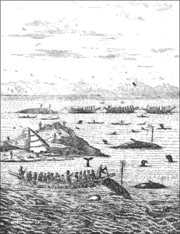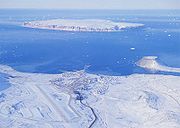
Comer's Midden
Encyclopedia
Comer's Midden is a 1916 archaeological excavation site near the
"Arctic Station of Thule
" (also called Qaanaaq
), north of Mt. Dundas (near Pituffik
), in North Star Bay, northern Greenland
. It is the find after which the Thule culture is named. The site was first excavated in 1916 by whaling Captain George Comer
, ice master of the Crocker Land Expedition
's relief team, and members of Knud Rasmussen's Second Danish Thule Expedition who were in the area charting the North Greenland coast.
With his ship ice-bound, Comer made use of his time through an archaeological excavation just south of Arctic Station of Thule unearthing, amongst other things, a kitchen-midden
made by paleo-Eskimo
s. The site is named in honor of Comer and the midden that he found.
1920s
Anthropologist Therkel Mathiassen
accompanied Rasmussen's 5th Thule Expedition (1921—1924) that included a return to the Thule site. In Mathiasen's monumental works of the 1920s and 1930s, he described Comer's Midden as "the only substantial find of pure Thule culture in Greenland".
1930s and 1940s
The site was excavated by Erik Holtved
in 1935 to 1937, and again in 1946 to 1947.
 Habitation periods
Habitation periods
The site shows signs of having been inhabited from the 14th to the 20th century although Holtved reports that the 17th and 18th centuries are poorly represented.
Ruins
The site contains about 26 house ruins and several middens distributed over an area of about 120 m in width and stretching over 400 m inland with the midden Comer excavated located at its south end. The majority of the houses were more or less rounded, typically around 3m to 5m across and most likely residential. One house was rectangular 4.5m by 6m, with narrow platforms along two of the walls, was probably a "qassi" or "mens' house" and was probably used as a workshop and for social gatherings.
Artifacts
Subsequent to the initial finds, additional artifacts pertain to the Dorset culture
, as well as items of Norse
origin.
The vast majority of harpoon heads found are of the open socket type typical of the Thule culture.
 In 1910, Rasmussen and Peter Freuchen established a private trading post (Cape York
In 1910, Rasmussen and Peter Freuchen established a private trading post (Cape York
station) at Thule (Greenlandic
, Uummannaq), and a settlement area was established near it by local North Greenlandic Inuit. In 1953, Uummannaq was converted into Thule Air Force Base, and Uummannaq's residents were relocated to Qaanaaq
.
"Arctic Station of Thule
Thule
Thule Greek: Θούλη, Thoulē), also spelled Thula, Thila, or Thyïlea, is, in classical European literature and maps, a region in the far north. Though often considered to be an island in antiquity, modern interpretations of what was meant by Thule often identify it as Norway. Other interpretations...
" (also called Qaanaaq
Qaanaaq
Qaanaaq is the main town in the northern part of the Qaasuitsup municipality in northwestern Greenland. It is one of the northernmost towns in the world. The inhabitants of Qaanaaq speak the West Greenlandic language and many also speak Inuktun. The town has a population of 626 as of 2010...
), north of Mt. Dundas (near Pituffik
Pituffik
Pituffik is a former settlement in northern Greenland, located at the current site of the American Thule Air Base. The former inhabitants were relocated to the present-day town of Qaanaaq...
), in North Star Bay, northern Greenland
Greenland
Greenland is an autonomous country within the Kingdom of Denmark, located between the Arctic and Atlantic Oceans, east of the Canadian Arctic Archipelago. Though physiographically a part of the continent of North America, Greenland has been politically and culturally associated with Europe for...
. It is the find after which the Thule culture is named. The site was first excavated in 1916 by whaling Captain George Comer
George Comer
Captain George Comer was considered the most famous American whaling captain of Hudson Bay, and the world's foremost authority on Hudson Bay Inuit in the early 20th century....
, ice master of the Crocker Land Expedition
Crocker Land Expedition
The Crocker Land Expedition was an ill-fated 1913 expedition to investigate Crocker Land, a huge island supposedly sighted by the explorer Robert Peary from the top of Cape Colgate in 1906...
's relief team, and members of Knud Rasmussen's Second Danish Thule Expedition who were in the area charting the North Greenland coast.
Excavation phases
1916With his ship ice-bound, Comer made use of his time through an archaeological excavation just south of Arctic Station of Thule unearthing, amongst other things, a kitchen-midden
Midden
A midden, is an old dump for domestic waste which may consist of animal bone, human excrement, botanical material, vermin, shells, sherds, lithics , and other artifacts and ecofacts associated with past human occupation...
made by paleo-Eskimo
Paleo-Eskimo
The Paleo-Eskimo were the peoples who inhabited the Arctic region from Chukotka in present-day Russia across North America to Greenland prior to the rise of the modern Inuit and/or Eskimo and related cultures...
s. The site is named in honor of Comer and the midden that he found.
1920s
Anthropologist Therkel Mathiassen
Therkel Mathiassen
Therkel Mathiassen was an archaeologist, anthropologist, cartographer, and ethnographer notable for his scientific study of the Arctic....
accompanied Rasmussen's 5th Thule Expedition (1921—1924) that included a return to the Thule site. In Mathiasen's monumental works of the 1920s and 1930s, he described Comer's Midden as "the only substantial find of pure Thule culture in Greenland".
1930s and 1940s
The site was excavated by Erik Holtved
Erik Holtved
Dr. Erik Holtved was a Danish artist, archaeologist, linguist, and ethnologist...
in 1935 to 1937, and again in 1946 to 1947.
Archaeological finds

The site shows signs of having been inhabited from the 14th to the 20th century although Holtved reports that the 17th and 18th centuries are poorly represented.
Ruins
The site contains about 26 house ruins and several middens distributed over an area of about 120 m in width and stretching over 400 m inland with the midden Comer excavated located at its south end. The majority of the houses were more or less rounded, typically around 3m to 5m across and most likely residential. One house was rectangular 4.5m by 6m, with narrow platforms along two of the walls, was probably a "qassi" or "mens' house" and was probably used as a workshop and for social gatherings.
Artifacts
Subsequent to the initial finds, additional artifacts pertain to the Dorset culture
Dorset culture
The Dorset culture was a Paleo-Eskimo culture that preceded the Inuit culture in Arctic North America. It has been defined as having four phases, with distinct technology related to the people's hunting and tool making...
, as well as items of Norse
Norsemen
Norsemen is used to refer to the group of people as a whole who spoke what is now called the Old Norse language belonging to the North Germanic branch of Indo-European languages, especially Norwegian, Icelandic, Faroese, Swedish and Danish in their earlier forms.The meaning of Norseman was "people...
origin.
The vast majority of harpoon heads found are of the open socket type typical of the Thule culture.
Re-settlement

Cape York (Greenland)
Cape York is a cape on the northwestern coast of Greenland, in northern Baffin Bay. The cape, located west-south-west of the Savissivik settlement, delimits the northwestern end of Melville Bay, with the other end commonly defined as Wilcox Head, the western promontory on Kiatassuaq Island.-...
station) at Thule (Greenlandic
Greenlandic
Greenlandic may refer to:* Something of, from, or related to Greenland, the self-governing Danish province located between the Arctic and Atlantic Oceans, east of the Canadian Arctic Archipelago....
, Uummannaq), and a settlement area was established near it by local North Greenlandic Inuit. In 1953, Uummannaq was converted into Thule Air Force Base, and Uummannaq's residents were relocated to Qaanaaq
Qaanaaq
Qaanaaq is the main town in the northern part of the Qaasuitsup municipality in northwestern Greenland. It is one of the northernmost towns in the world. The inhabitants of Qaanaaq speak the West Greenlandic language and many also speak Inuktun. The town has a population of 626 as of 2010...
.

